Start seeds indoors now for big, beautiful Spring plants.
We have a small but specially-selected variety of seeds, chosen mostly for their beneficial uses, like herbal medicines, foods, seeds, pollinator attractants, and such.
These seeds are harvested from our own plants, which have been grown in our own vermicasts & organic amendments.
We get excellent germination rates, and healthy plants, and you should expect the same of these seeds.
We are also always happy to help by answering questions, supplying advice, or whatever we can do to ensure a beautiful, happy, healthy and productive garden.
Boutique Seeds n Such:
Heard the saying “You are what you eat”? That goes across the entire food chain. Better soils create better plants & flowers, which create better seeds.
Our seeds are harvested from our own plants which were grown in our own top-quality organic soils, which have been fed with our own top-quality feeds.
We typically see 90% – 100% germination rates. Check back as we’re adding varieties frequently.
Purple Cherokee Tomato – Purple Cherokee is a tomato that develops a fruit with a deep, dusky-rose color while maintaining a somewhat greenish hue near the stem when mature for eating.
Purple Cherokee tomatoes are beefsteak in style. They are also notable for having a dense, juicy texture. The comparatively dark interior color is enhanced by the tendency of the seeds to be surrounded by green gel.
This tomato is best enjoyed fresh and is often used in BLT sandwiches and salads. It can also be used when making pizza and pasta.

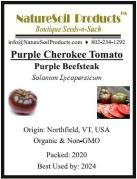

Black Cherry Tomato (Heirloom) – Once you try the Black Cherry Tomato, you won’t be able to stop!
This black tomato variety is really the only true black cherry tomato cultivator.
This tomato plant will produce huge yields in clusters of 1 inch, round, deep purple, almost black tomatoes.
The Black Cherry is an irresistibly delicious treat with sweet, rich, complex and full tomato flavors.

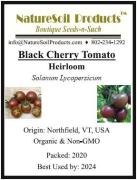

Sweet Orange Cherry Tomato – The Sweet Orange Cherry Tomato is one of the sweetest cherry tomatoes available.
This Sweet Orange Cherry Tomato plant will produce huge yields in clusters of 1 inch, round, bright orange tomatoes.
The Sweet Orange Cherry is an irresistibly delicious treat with sweet, rich, complex and full tomato flavors.
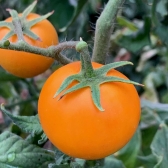


Sweet Red Grape Tomato – The Sweet Red Grape Tomato is tiny but packs a huge burst of sweetness.
This Sweet Red Grape Tomato plant will produce large yields in clusters of 1/2-1 inch, oval, bright red, tomatoes.
The Sweet Red Grape is an irresistibly delicious treat with sweet, rich, complex and full tomato flavors.
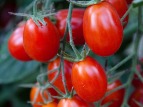


Mild Yellow Pear Tomato – This Mildly Sweet Yellow Pear Tomato plant will produce huge yields in clusters of 1-1/2 inch, pear-shaped, bright yellow tomatoes.
The Mildly Sweet Yellow Pear is an irresistibly delicious treat with mildly sweet, rich, complex and full tomato flavors.


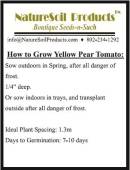
Flowering Tobacco (Nicotiana Alata) – Beautiful trumpet-shaped flowers in various colors. One of the most fragrant & sweetest-smelling flowers we’ve grown.
Over 2,500 seeds per pack.
A favorite of pollinators (numerous studies show that not only is the floral nicotine not harmful to pollinators, but that it is even beneficial, enabling quicker learning and perhaps protecting against parasitic pests).
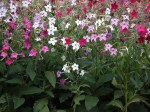


Morning Glory – Vining w/flowers of various colors.
Favored by Bees (mostly Bumble Bees).
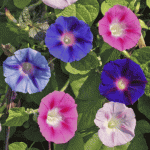
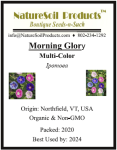

Sweet William (Pink – Dianthus barbatus) – a herbaceous biennial or short-lived perennial plant growing to 13–92 cm tall, with flowers in a dense cluster of up to 30 at the top of the stems. Each flower is 2–3 cm diameter with five petals displaying serrated edges.
Sweet William (Red – Dianthus barbatus) – a herbaceous biennial or short-lived perennial plant growing to 13–92 cm tall, with flowers in a dense cluster of up to 30 at the top of the stems. Each flower is 2–3 cm diameter with five petals displaying serrated edges.




Yellow Mustard (Brassica Juncea) – Aka Brown Mustard, Indian Mustard.
Annual with small yellow flowers.
The leaves, seeds, and stems of this mustard variety are edible.
The mustard condiment made from the seeds of the B. juncea is called brown mustard and is considered to be spicier than yellow mustard.
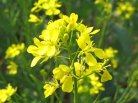


Golden Flax (aka Linseed) – Flax is cultivated as a food and fiber crop in cooler regions of the world.
Flax is also grown as an ornamental plant in gardens, with often blue to purple flowers.
Flax seed can be used whole, ground down to a powder or sprouted. Flax sprouts are known for their spicy taste.
A 100-gram portion of ground Flax seed supplies about 534 calories (2,230 kJ), 41 g of fat, 28 g of fiber, and 20 g of protein.



Purple Hyacinth Bean (aka Jefferson Bean)– Vining with purple flowers. Flowers and beans are edible. Used as a substitute for Soy in making tofu for those with soy allergies.
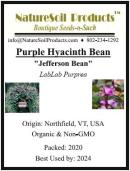
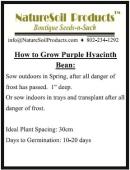
Breadseed Poppy (aka Florists Poppy, Papaver Somniferum) – Annual with mostly papery purple flowers. Pods can be used in cut or dried floral arrangements.
Seeds are edible, and often used in baking, in salads, sprinkled into cereal or oatmeal, and other culinary uses.

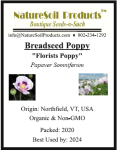

Corn Poppy (aka Flanders Poppy, Papaver Rhoeas) – Annual with mostly papery red flowers. Pods can be used in cut or dried floral arrangements.
Seeds are edible, and often used in baking, in salads, sprinkled into cereal or oatmeal, and other culinary uses.



Daisy – A classic flower.
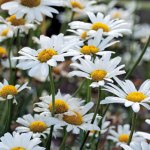
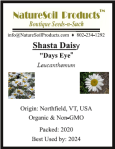

Milkweed (aka Silkweed, Monarch Butterfly Plant) – Necessary as food for Monarch butterflies. Researchers have identified the reduction in Milkweed plants as the main cause in the ongoing vast loss of Monarch butterflies. Perennial.
Young leaves can be cooked (steamed) and eaten.
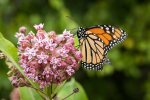
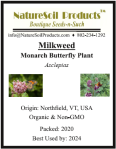
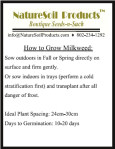
Burdock (aka Little Burdock, Wild Rhubarb) – Flowing biennial in the daisy family with prickly flowers that are pink to lavender in color. Flower heads are about 2 cm (0.79 in) wide. blooming from mid to late summer.
You may wonder why anyone would willingly plant this “weedy” plant.
The leafstalks (a year old or younger) and flower stalks can be eaten raw or cooked.
The seeds can be eaten, raw or roasted, or used as bird seed.
The roots are edible boiled with a change of water, and can be pickled or added to stir-fry.
Burdock & Dandelion is a beverage consumed in the British Isles since the Middle Ages, and possesses numerous medicinal qualities.
Bees and other beneficial pollinators love these flowers.

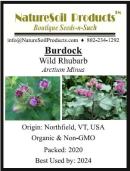
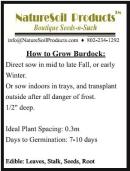
Purple Coneflower (aka Echinacea) – Herbaceous flowing perennial in the daisy family with large, showy heads of composite flowers blooming from early to late summer.
Frequently used in folk medicine to boost immunity.

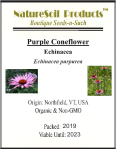

Cutleaf Coneflower – “Golden Glow” – Herbaceous flowing annual to perennial in the sunflower family with large, showy heads of composite flowers blooming from early to late summer.
The “Golden Glow” variety has yellow flowers and a pronounced yellow to greenish cone.
The young leaves can be gathered and eaten in the early spring. They are greatly favored as a potherb (cooked). Some references state the use of this plant as salad greens (raw).

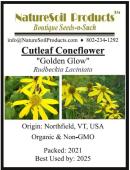
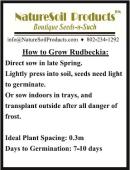
Black-Eyed Susan – “Moreno” – Herbaceous flowing annual to perennial in the sunflower family with large, showy heads of composite flowers blooming from early to late summer.
The “Moreno” variety has mahogany-red fading to orange-tipped ray flowers and a pronounced dark purple to black cone.
Roots have been used in folk medicine to boost immunity.
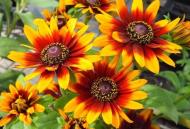
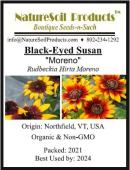
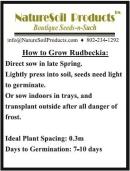
Black-Eyed Susan – “Indian Summer” – Herbaceous flowing annual to perennial in the sunflower family with large, showy heads of composite flowers blooming from early to late summer.
The “Indian Summer” variety has yellow flowers and a pronounced dark purple to black cone.
Roots have been used in folk medicine to boost immunity.
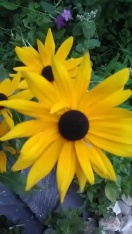
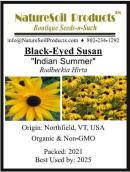

New England Aster (aka Michaelmas Daisy) – Herbaceous flowering perennial. abundant flower heads are showy with yellow disc florets at the center and ray florets that range from a deep purple or rose pink to rarely white. A favorite of pollinators.
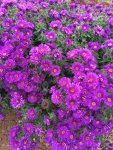

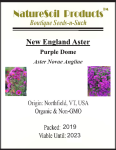

Cornflower (aka Bachelor’s Button) – An annual plant growing to 40–90 cm tall, with grey-green branched stems.
The flowers typically range in color from blue, pink, lavender, and white, produced in flowerheads 1.5–3 cm diameter, with a ring of a few large, spreading ray florets surrounding a central cluster of disc florets.
The edible flower of the cornflower can be used for culinary decoration, for example to add color to salads.
Cornflowers have been used historically for their colorful pigment.
Cornflowers are often used as an ingredient in some tea blends and herbal teas.
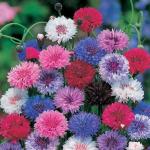
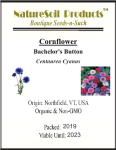

Cosmos – Herbaceous perennial or annual plants growing 0.3–2 m (1 ft 0 in–6 ft 7 in) tall.
The leaves are simple, pinnate, or bipinnate, and arranged in opposite pairs. The flowers are produced in a capitulum with a ring of broad ray florets and a center of disc florets; flower color is variable but frequently pink, scarlet, white, and red.
Smaller birds love to sit on Cosmos stems and eat the seeds in Fall.
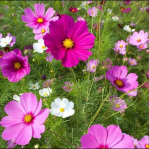
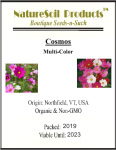

Pricing:
$2.50/packet.
More to come…….
NatureSoil Products™ – Born of Nature. Back to Nature.
